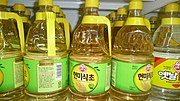Rice vinegar
Rice vinegar ( Japanese Komesu 米 酢 ) is vinegar made from fermented rice or rice wine . Rice vinegar is a mild vinegar because it only contains three to four percent acetic acid .
Acidity
Compared to the brandy vinegar , fruit vinegar or vinegar made from grape wine common in Europe , rice vinegar is usually milder, as it contains less acetic acid - only around three to four percent instead of five to six percent. However, this is not due to the raw material, but to the wishes of Asian consumers who prefer a milder vinegar. In principle, rice vinegar would become just as strong as other types of vinegar using the same process. In Germany, vinegar must contain at least five percent acid by law, but in the case of rice vinegar, the authorities apparently refrain from enforcing this rule.
Condiments
Rice vinegar is often used to flavor the rice for sushi . It is often used as sushinoko , which is a rice vinegar powder mixture for rice cooking water. In this powder, the acetic acid, which is itself a liquid and therefore cannot be dried directly, is chemically bound. Acetic acid is only produced again when it comes into contact with water. One teaspoon is enough for about 300 grams of rice. Rice vinegar is also used to make side dishes, to flavor soups and for marinating .
diet
Rice vinegar is often recommended (like apple cider vinegar and a few other types of vinegar) for weight loss and detoxification . Like conventional vinegar, rice vinegar stimulates digestion, but has a milder taste.

